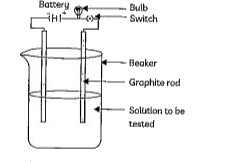On exposure to light, electrical conductivity of selenium
A
Decreases
B
Increases
C
Remains increases, then decreases
D
First increases, then decreases.
Video Solution
Text Solution
The correct Answer is:B
|
Answer
Step by step video, text & image solution for On exposure to light, electrical conductivity of selenium by Chemistry experts to help you in doubts & scoring excellent marks in Class 12 exams.
Updated on:21/07/2023Topper's Solved these Questions
- THE NOBLE GASESBOOK - DINESH PUBLICATIONCHAPTER - THE NOBLE GASESEXERCISE - Brain Teasers - 20
40 Videos
- THE NOBLE GASESBOOK - DINESH PUBLICATIONCHAPTER - THE NOBLE GASESEXERCISE - Ultimate Preparatory Package
10 Videos
- THE NITROGEN FAMILYBOOK - DINESH PUBLICATIONCHAPTER - THE NITROGEN FAMILYEXERCISE - Ultimate
14 Videos
- THE OXYGEN FAMILYBOOK - DINESH PUBLICATIONCHAPTER - THE OXYGEN FAMILYEXERCISE - PREPARATORY PACKAGE
14 Videos
Similar Questions
Knowledge Check
The electrical conductivity of semiconductor is
A108ohm−1cm1B10−22ohm−1cm1CIn the range of 10−9 to 102ohm−1cm−1DNone of the aboveThe electrical conductivity of semiconductors ……. With increase of temperature.
AIncreases with temperatureBDecreases with temperatureCRemains constant on heatingDAll the aboveThe electrical conductivity of semiconductors
AIncreases with temperatureBDecreases with temperatureCRemains constant on heatingDAll the above
The nonmetal having electrical conductivity.
View SolutionElectrical conductivity of a semiconductor
View SolutionElectrical conductivity of a semiconductor
View SolutionThe unit of electrical conductivity is
View SolutionAssertion: Electrical conductivity of copper inicreases with increase in temperature.
Reason: The electrical conductivity of metals is due to the motion of electrons.
View Solution
